 |
The Biennial in Lyon was highly recommended to
me. So I booked a seat on the TGV and a night at the "Hotel
Premiere Class" (a no-frills hotel that I like because it is clean,
inexpensive, and has a kind of futuristic prefab sameness to it and is
available no
matter where you go in France.)
I figured two days would be
sufficient to see everything. I was wrong. I could have
used another day.
|
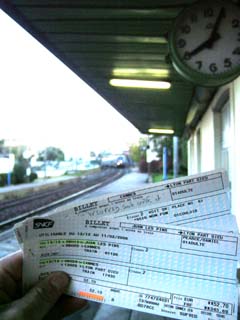
|
The disadvantage of
traveling near the holidays in France is that this is also the
favorite time to
schedule transportation strikes. The French consider the "greve"
to be a patriotic expression of their faith in the state
to solve all problems. Strikes are prescheduled and widely
advertised so that anyone with a swelling of national pride can arrange
to participate. Being a foreigner, I was oblivious to this
celebration and only clued in when my train didn't arrive. After
wandering home, returning when the station was supposed to be open,
rescheduling to a different train and waiting for a few hours I
was beginning to feel a certain desire for governmental intervention
as well.
|

|
The TGV is more like
an aircraft in the smoothness of its ride and the speed at which things
move by outside but several aspects remind you that it is a train: the
space and comfort of the seats and ability to move around; the person
sitting next to you might change a couple of times
before you get to your destination; you never really know which
direction the train will leave a station. I was facing foreword
going into Marseilles but left facing backwards.
The most astonishing thing
though is when you pass another TGV going the opposite direction, at a
closing speed of nearly 400 mph, only a few feet away. A 500 foot
long train appears in your window so fast that you barely have time to
recognize it
before it is gone (less than a second) but the sudden noise and shaking
of the cab make it
impossible to ignore.
|
 |
The Lyon Biennial was
curated around the theme "Experiencing Duration" so all of the
exhibits dealt with time in some sense. This is a favorite topic
of mine so I was interested to see what other artists had been
exploring. I was particularly pleased when I qualified as a
"student of art". I viewed this as a sort of acknowledgment from
the French government. Maybe I'll join the next strike.
|
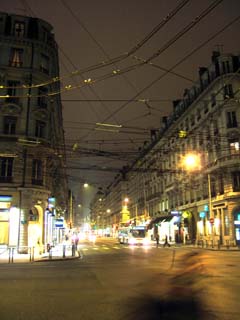
|
The biennial was
spread over five
separate venues in the heart of Lyon but the brochure gave clear and
easy to follow directions on how to get between any combination of them
using the bus, tram, or an odd cross between the two (which looked like
a train but had tires). They even set up a special bus and a boat
service to make some of the remote sites more easy to access. All
of that, of course, depended on actually having a brochure, which I did once
I found the first venue. To get started, I just picked the most
obvious and more
or less isolated venue and walked. It always takes me a little
while to get oriented to a new town and I
find that walking allows me to register both the landmarks and the
character of a place. Lyon is the second
largest city in France (tied with Marseille) and has its fair share of
urban problems but the
downtown area in which I traveled was inviting and bustling with
activity.
The Musee d'Art Contemporain de Lyon (Lyon Museum of
Contemporary Art) is adjacent to a large
park on the northern end of downtown. Inside was a number
of ambitious multimedia installations including one
where Dieter Roth presented 31,000 slides that were taken of every
facade in the city of Reykjavik, Iceland. The first half were
taken in the 70s and the second showed the same facades twenty
years later. Oh man. I think the point was how similar and
ordinary they were but I didn't stay to watch them all. Perhaps
some of the slides I missed were interesting.
Another
was a piece where Brian Eno presented his idea of a Night Club where
you could go to relax instead of be stimulated. It was complete
with
his own composition of New-Age music and mobiles that cast shadows to
demonstrate red/green/blue additive perception of color. That was
interesting. A gaggle
of teenage art students had other opinions about how to spend their
time and the resulting conflict between them and the museum guard was
fun to watch but not really relaxing.
|
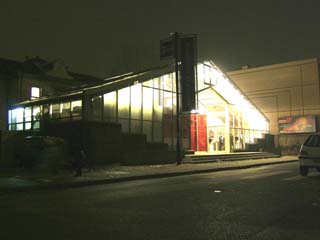 |
The l'Institut d'Art
Contemporain (Contemporary Art Institute) had a number of interesting
pieces that
dealt with time as a historical measure, like a presentation of
original comic book drawings by R. Crumb, that showed his (ongoing)
experience of the 60s. Other displays were the
remnants of
a performance piece where some brief choreographed action took
place. The idea was to see the paint splashed on the wall and
think of the other period of time and imagine having been invited to be
there.
Several pieces seemed to
be deliberately long so that you would have to invest quite a bit of
time to get the full story. My favorite was a piece by James
Turrel in which you had to navigate through the dark down a long
winding labyrinth to sit in a folding chair in the dark and wait.
The
accompanying text had warned that you would have to sit for fifteen
minutes or you wouldn't see anything. I arrived too close to
closing time the first night and so had to return when the exhibit
reopened at noon the next day. I waited the prescribed
fifteen
minutes. The piece was barely visible to the fully dilated
pupil. Just a very dim red glow that at first I wasn't sure was
really there. I tested it by looking other directions and
convinced myself it was really
there. Just as I was checking to
see if there was enough light to form a silhouette of my hand the
attendant called down the entry, "Pardon Monsieur, c'est fini".
So
that was it. He's famous by the way. Does a lot of that
kind of thing.
|
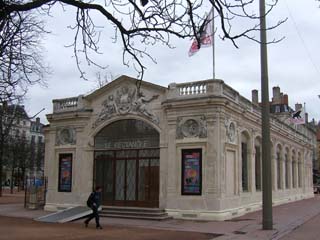
|
The next stop was to
see Wim Delvoye's solo exhibition in Le Rectangle. Wim is the
fellow I wrote of in November who is famous for making a
fourty-foot-long
machine that models the human digestive system. His exhibition
here was also about food. The main room was a display of his
collection of "Vache Qui Rit" (Happy Cow) labels dating from the 1950s
to
the present and covering all kinds of export versions. The logo
of the happy cow slowly changed to be ever more happy and less cow-like
yet remained pretty much uniform from country to country. The
"special offers" like stuff from Disney movies of various times or
soccer stars of different countries offered a kind of navigation
through culture and time.
Well, that and the various languages of course. Oh, and the
Fifties version
of the label proudly declares that it is 50% fat (the second
ingredient is butter) while the latest labels discretely promises less
than 10% fat. Times change.
|

|
The other display by
Wim was for pigs. One room had a live webcam of his pig farm in
China where he has gone through some effort to raise happy pigs.
The
walls of the gallery had projections of the inside of the stie so that
you were surrounded by images of pigs grunting, sleeping and doing
ordinary pig
stuff (but without the smell). Next door, the hides of deceased,
and I presume
consumed, pigs
hung in frames on the walls. The fashion conscious pigs had
been tattooed with various designs like Louis Vitton (a high-end
designer label of leather goods) or Hells Angles emblems or
various political messages done in tattoo format. I wasn't
allowed to take pictures while inside so I shot through the window from
outside. I'm not
sure if the museum assumes that it also owns any light that happens to
escape the building but I figured they wouldn't miss a few
photons.
|
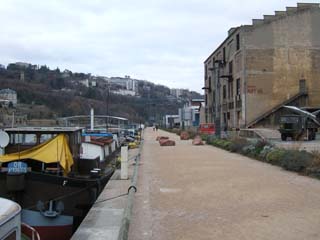
|
The fourth and last
venue that I had time to visit was the Suciere (sugar factory) down on
the
water front along the Rhone. Tied up on the bank were various
barges that people use for travel and to live in. You see these
along a lot of the bigger rivers in France and they must form a kind of
transient community of vessels and inhabitents. I had a chance to
try this for a few days one year and
it was great. Each day we moved our whole dwelling to a new
village
and snuck in from what has become the back door to town. We spent
the night as sort of residents (even went to a Bastille Day party) and
in the morning took part in the
local cheese, bread, etc. Some barges are quite fancy and
spacious but many are run down. The Biennial even converted one
into a restaurant but I didn't have time to eat there (I grabbed a
crepe on the street on the way over.) Artists tend to move around
to various abandoned parts of town, fix them up, then move on when the
trendy people move in. Its sort of a community service. For
the time being the Suciere, the neighboring warehouses and these
moorings are beyond
the end of the tram line and seem to belong to the art community.
|
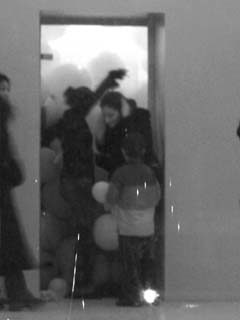 |
Following my habit of
clandestine documentation of French cultural events, I shot this image
through the window from outside the suciere toward the exit of one of
the more popular exhibits. Martin Creed filled a room half full
to the ceiling with pink balloons and arranged for the attendants to
carefully
coordinated the admission of a few people at a time to navigate from
one end to the other. Going in was easy because the balloons just
scattered ahead of you but getting to the exit became tough as the
balloons in front of you started getting trapped against the facing
wall. Then people came in behind you and you became trapped in a
balloon cacoon. I felt like a molecule condensing into a
solid. The static on the balloons made them stick to your hair so
that what started out as playful became a little on the nightmarish
side by the end. The exit attendant was trying to keep all the
balloons in the room and starting talking to me or perhaps to his
"talky-walky" I couldn't tell, it was in French. I finally made
it
out with my hair standing on end.
Another piece with a similar effect was an installation of
"green". That's it. Just green. The entire room was
full of artificial smoke that was lit with green lights so that you
could not discern any feature in the room at all except that you were
surrounded by green. Yves Klien tried to do this with his
monochrome blue paintings but I don't think he ever succeeded as
well. The viewer was forced to immerse themselves in the color
green because there was no other reference at all. I think you
were supposed to forget "time".
There were three floors in this large sugar warehouse of
similar explorations in perception or ways of interacting with the
viewer or ways of presenting a moment or period of time. Some
were just a record of some previous effort like Tom Marioni's piece
"Free Beer" where thirteen
beers were consumed by friends during the opening of the biennial, or
where a sculpture existed only briefly like his "One Second Sculpture"
where he threw a coiled tape measure into the air and
it sprung open forming a sculpture in mid-air before falling to the
ground
after it had straightened itself out. There was a time not so
long
ago when I would have rolled my eyes and grumbled about this sort of
thing. Now (I say this with some trepidation) it seems to be
making sense.
|









